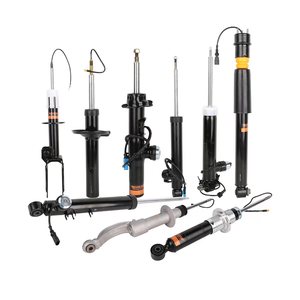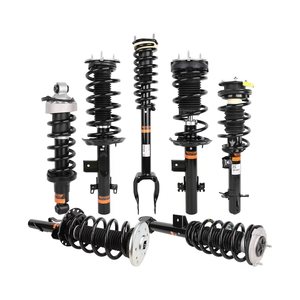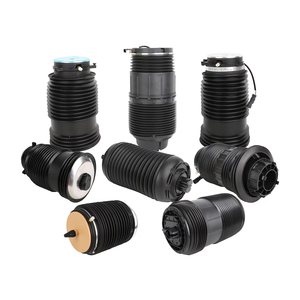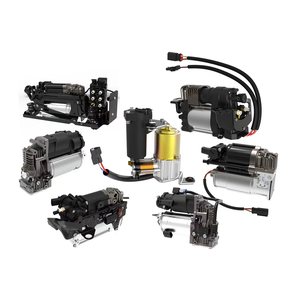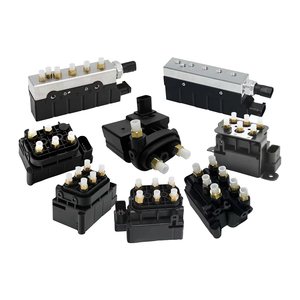Types of Telescopic Shock Absorbers
A telescopic shock absorber is a crucial component of a vehicle's suspension system that helps maintain stability and control while driving. It minimizes the impact of bumpy roads on the vehicle's body, ensuring the occupants' comfort. Generally, there are two main types of telescopic shock absorbers, namely, twin-tube shocks and mono-tube shocks.
Mono-tube Shock Absorber
A mono-tube shock absorber features a single cylindrical steel tube that contains both gas and fluid. Positioned under the vehicle, it directly absorbs road impacts, making it ideal for off-road and high-performance vehicles.
| Key Features | Benefits |
|---|---|
| Single cylinder design | Simplified construction, better heat dissipation |
| Piston divides fluid into chambers | One for compression, one for extension |
| Consistent temperature resistance | Reliable performance in varied conditions |
| Quick response to surface changes | Automatic damping rate adjustment |
| Lightweight design | Improved handling and stability |
| Low maintenance requirements | Long-term reliability |
Best for: High-performance vehicles, off-road applications, premium vehicles
Twin-tube Shock Absorber
The twin-tube shock absorber utilizes two concentric tubes: an inner tube containing gas and hydraulic fluid, and an outer tube serving as a fluid reservoir. This design offers cost-effectiveness at the expense of some performance characteristics.
| Key Features | Characteristics |
|---|---|
| Dual-tube construction | Inner working tube and outer reservoir tube |
| Cost-effective design | More affordable than mono-tube variants |
| Temperature sensitivity | Performance affected by temperature changes |
| Lower response speed | No automatic damping rate adjustment |
| Wide application | Common in budget-friendly vehicles |
| Higher maintenance needs | Requires more regular servicing |
Best for: Everyday driving, budget-conscious applications, standard passenger vehicles
Expert Tip: When choosing between mono-tube and twin-tube shock absorbers, consider your vehicle's primary use. For performance driving or off-road adventures, the responsive nature of mono-tube shocks may justify their higher cost. For daily commuting on paved roads, twin-tube shocks often provide adequate performance at a more affordable price point.
Specifications & Maintenance of Telescopic Shock Absorbers
The specifications of telescopic shock absorbers vary depending on their intended application and vehicle requirements. Understanding these specifications is crucial for selecting the right shock absorber for your specific needs.
| Specification | Description | Importance |
|---|---|---|
| Type | Mono-tube, twin-tube, gas, or hydraulic | Determines performance characteristics and application suitability |
| Size | Length and diameter measurements | Must match vehicle mounting points exactly |
| Stroke Length | Piston travel distance within cylinder | Affects suspension movement control |
| Force Rating | Measured in newtons | Determines resistance level and load capacity |
| Mounting Type | Eyelet, stem, or specialized | Must be compatible with vehicle suspension design |
| Compression/Rebound Ratio | Balance between shortening and lengthening | Affects vehicle stability and ride quality |
Effective Maintenance Practices
Conduct routine visual checks to identify signs of wear, damage, or fluid leakage. Look for oil streaks on the shock body, which indicate seal failure.
If leakage is detected, address it immediately. In most cases, a leaking shock absorber will need replacement as internal seals are typically not serviceable.
Regularly inspect and tighten mounting hardware to manufacturer specifications. Loose mounts can cause premature wear and compromise performance.
Keep shock absorbers clean from road debris, mud, and salt. Use mild soap and water, avoiding harsh chemicals that may damage seals or protective coatings.
Adhere to vehicle weight limits. Overloading puts excessive strain on shock absorbers, leading to premature failure and compromised safety.
Warning: Neglecting proper shock absorber maintenance can lead to decreased vehicle stability, increased stopping distances, uneven tire wear, and compromised safety, especially in emergency maneuvers.
How to Choose Telescopic Shock Absorbers
Selecting the right telescopic shock absorber requires careful consideration of various factors to ensure optimal performance and customer satisfaction. Whether for personal use or resale, understanding these selection criteria is essential.
Vehicle Compatibility
The primary consideration when selecting shock absorbers is compatibility with the specific vehicle make and model. Factors include:
- Vehicle weight and distribution
- Suspension design and mounting points
- Original equipment specifications
- Intended driving conditions
Best practice: Always consult manufacturer specifications or use vehicle-specific lookup tools
Performance Requirements
Different driving styles and conditions demand varying shock absorber characteristics:
- Standard/OEM replacement: Balanced comfort and handling for everyday driving
- Heavy-duty: Enhanced durability for towing, hauling, or off-road use
- Performance: Improved handling and road feedback for sporty driving
- Comfort-oriented: Maximized ride quality for luxury vehicles
Consideration: Assess the primary vehicle use case to determine optimal performance profile
Selection Tip: When choosing between gas-charged and hydraulic shock absorbers, consider that gas-charged options generally offer better performance across a wider range of conditions, resist fading during heavy use, and provide more consistent damping. However, they typically come at a higher price point compared to standard hydraulic designs.
Key Selection Factors
| Factor | Considerations | Importance |
|---|---|---|
| Size & Fit | Must match vehicle's mounting specifications exactly | Critical |
| Type Selection | Mono-tube vs. twin-tube based on performance needs | High |
| Construction Quality | Materials, seals, and internal components | High |
| Warranty Coverage | Length and terms of manufacturer guarantee | Medium |
| Price Point | Balance between budget and performance requirements | Medium |
| Brand Reputation | Track record for reliability and customer support | Medium |
DIY Replacement of Telescopic Shock Absorbers
Replacing shock absorbers can be a manageable DIY project for those with basic mechanical knowledge and proper tools. Following a systematic approach ensures safe and effective installation.
Required Tools
- Socket set with various sizes
- Combination wrench set
- Torque wrench (for proper tightening)
- Floor jack and jack stands
- Lug nut wrench
- Penetrating oil (for rusty bolts)
- Safety equipment (gloves, eye protection)
- New shock absorbers (vehicle-specific)
Safety Precautions
- Work on a level, solid surface
- Ensure vehicle is properly supported on jack stands
- Never rely solely on a jack to support the vehicle
- Use wheel chocks to prevent vehicle movement
- Allow vehicle to cool before working underneath
- Follow manufacturer's torque specifications
- Wear appropriate safety gear throughout
Replacement Procedure
Park the vehicle on a flat, level surface. Engage the parking brake and block the wheels opposite to those you'll be working on. Gather all necessary tools and the correct replacement shocks.
Use a floor jack to raise the vehicle at the manufacturer's recommended lifting points. Once elevated, secure with jack stands at approved support locations. Never work under a vehicle supported only by a jack.
Remove the lug nuts and take off the wheel to access the shock absorber. Place the wheel under the vehicle as an additional safety measure.
Locate the upper and lower mounting bolts of the shock absorber. Apply penetrating oil if bolts appear rusted. Remove the bolts using the appropriate socket or wrench. Carefully extract the old shock absorber.
Position the new shock absorber in the mounting location. Hand-tighten the bolts at both upper and lower mounts to ensure proper alignment. Once aligned, use a torque wrench to tighten to manufacturer specifications.
Reinstall the wheel and hand-tighten lug nuts. Lower the vehicle to the ground, then tighten lug nuts in a star pattern to manufacturer's torque specifications. Repeat the process for remaining shock absorbers.
Take the vehicle for a gentle test drive to ensure proper installation. Listen for unusual noises and check for even handling. The suspension may feel firmer than before with new shocks.
Important: If you encounter excessive rust, seized bolts, or components that differ significantly from replacement parts, consider consulting a professional mechanic. Forcing components can cause damage and compromise safety.
Frequently Asked Questions
Telescopic shock absorbers are neither inherently good nor bad - they are essential components of modern vehicle suspension systems. Their effectiveness depends on proper selection and application. Benefits include space efficiency and straightforward installation, while limitations may include reduced effectiveness under heavy loads compared to other suspension types. The quality and suitability of a shock absorber should be evaluated based on the specific vehicle requirements and driving conditions.
Telescopic shock absorbers serve multiple crucial functions in vehicle dynamics:
- Control excessive spring oscillation by converting kinetic energy into heat
- Maintain tire contact with the road surface for optimal traction and control
- Stabilize vehicle body movements during acceleration, braking, and cornering
- Minimize the transfer of road imperfections to the vehicle cabin
- Prevent excessive suspension travel that could damage components
- Contribute to overall vehicle handling characteristics and safety
The two primary types of telescopic shock absorbers are:
| Type | Description | Best Application |
|---|---|---|
| Mono-tube | Single larger cylinder containing both gas and hydraulic fluid | Performance vehicles, off-road use, premium applications |
| Twin-tube | Inner working tube and outer reservoir tube design | Everyday driving, economy vehicles, comfort-oriented applications |
These main types can be further categorized by their internal design as gas-charged or purely hydraulic systems, with various specialized subtypes for specific applications.
The typical lifespan of telescopic shock absorbers ranges from 30,000 to 50,000 miles (48,000 to 80,000 kilometers). However, actual longevity varies significantly based on multiple factors:
- Driving conditions: Rough roads, off-road use, and frequent impacts reduce lifespan
- Climate factors: Extreme temperatures and high humidity can accelerate wear
- Vehicle weight: Heavier vehicles place more stress on shock absorbers
- Driving style: Aggressive driving shortens service life
- Quality of components: Premium shock absorbers typically last longer
- Maintenance practices: Regular inspection and proper vehicle loading extend lifespan
Watch for signs of shock absorber wear, including excessive bouncing, nose-diving during braking, uneven tire wear, and fluid leakage, regardless of mileage.























